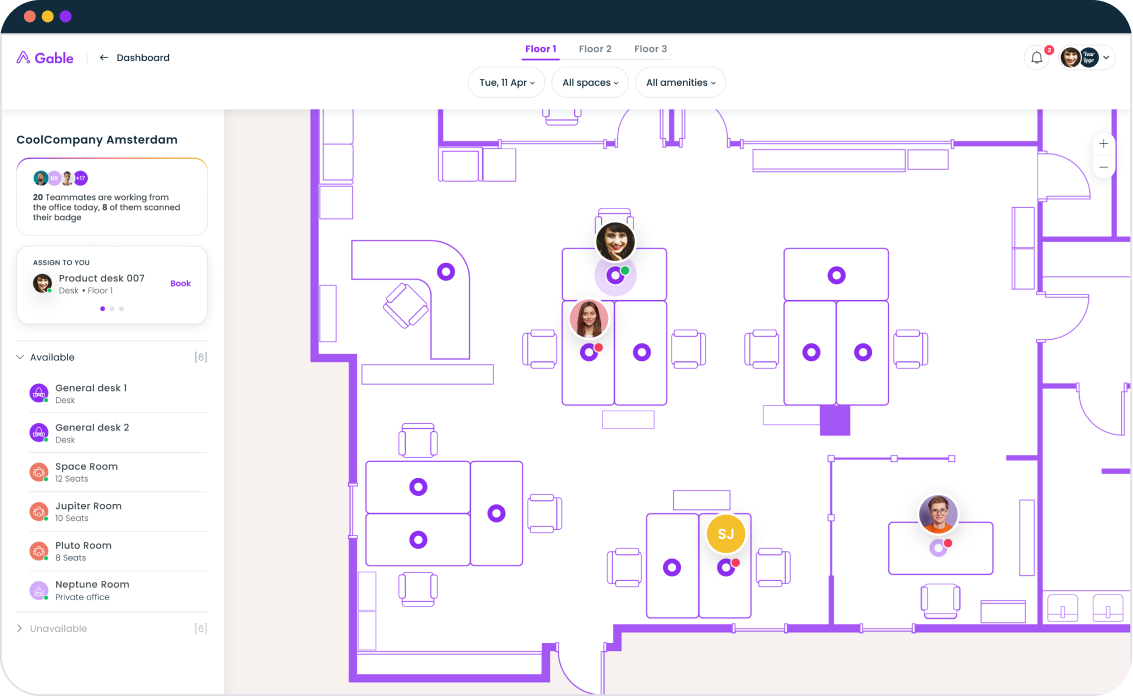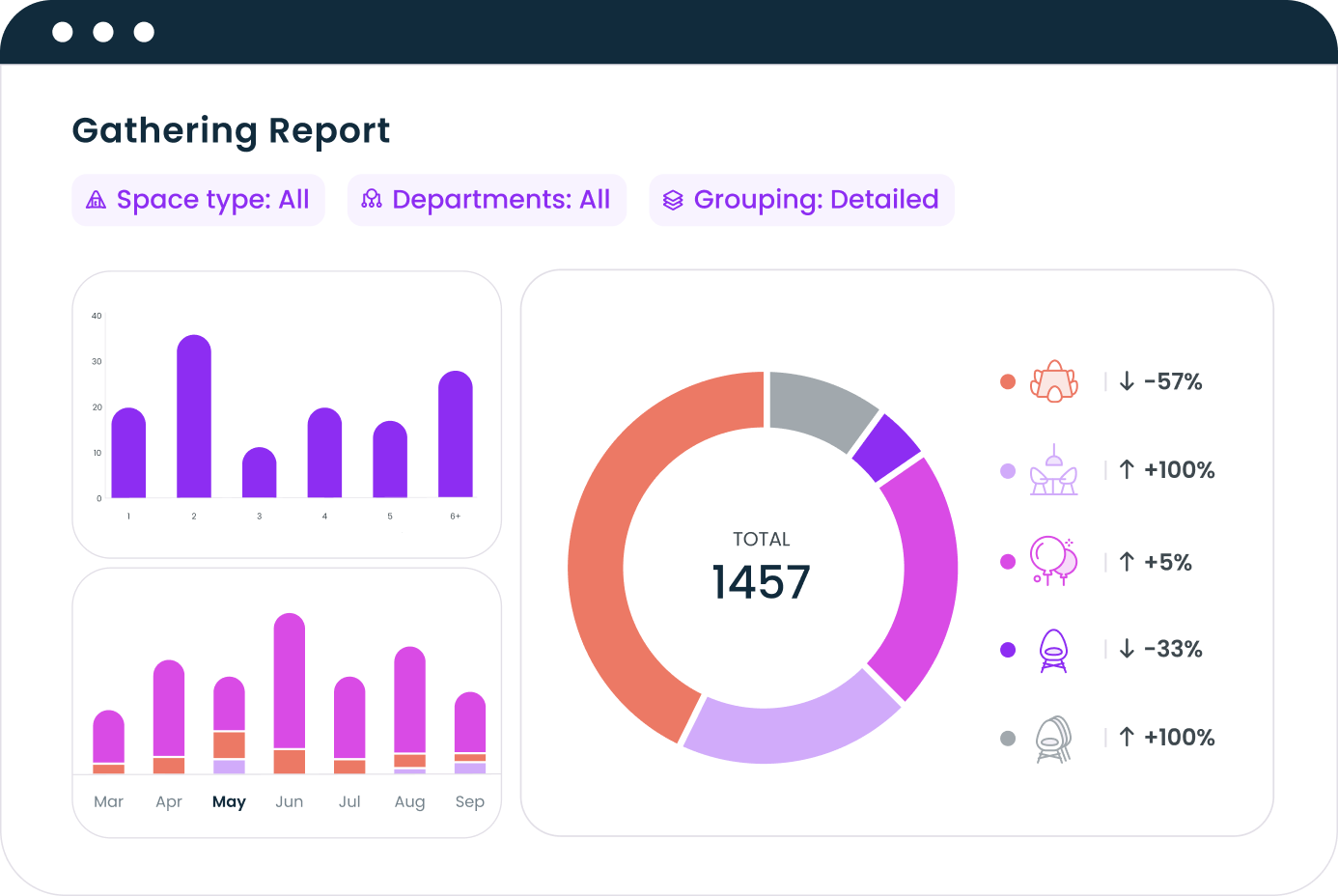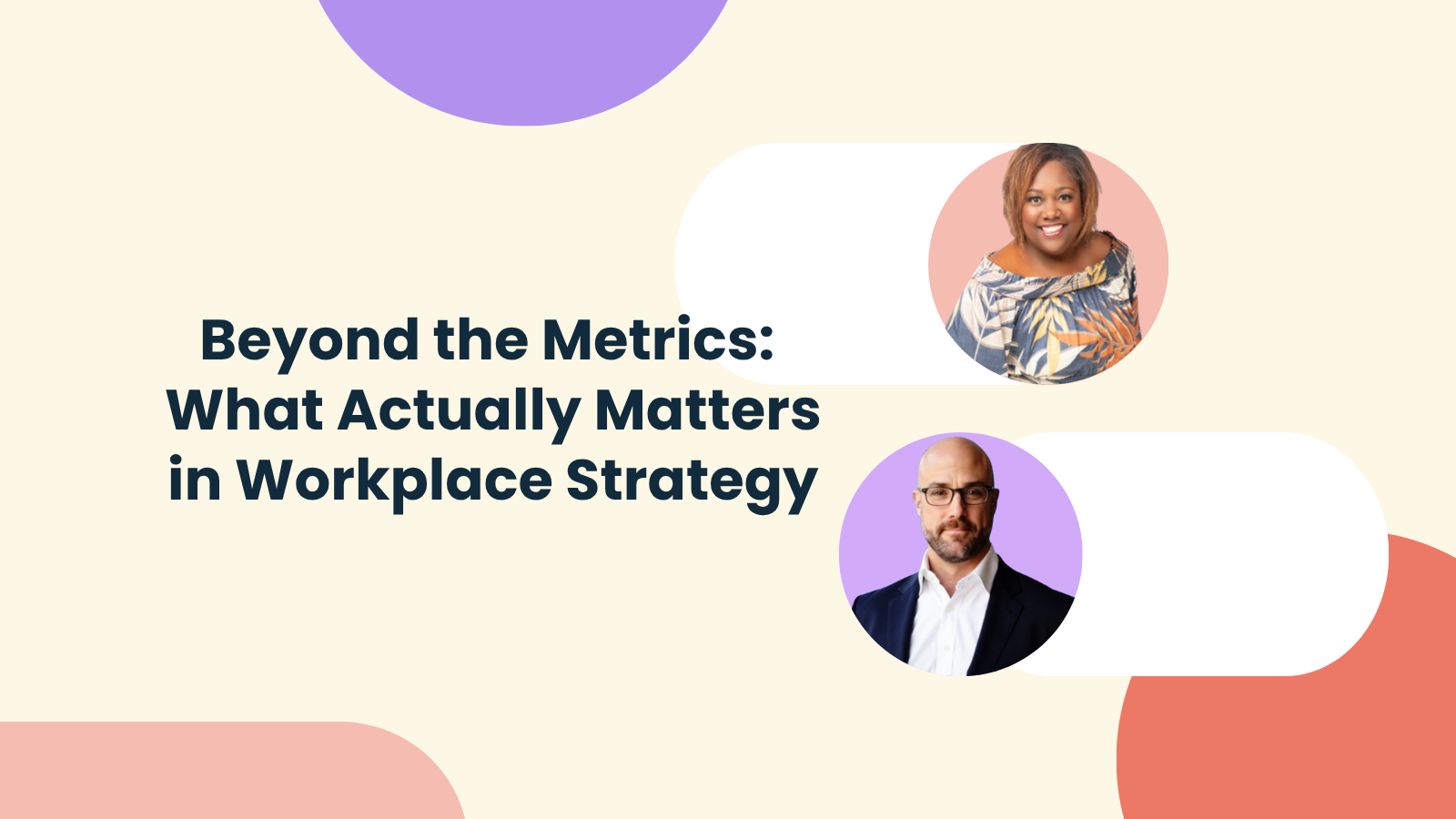AI delivers measurable ROI for workplace teams through three core applications: automating routine tasks (saving 2-4 hours weekly per employee), providing predictive analytics for space optimization (reducing costs 15-30%), and enhancing employee experience through intelligent systems. Start with high-impact use cases like space utilization analytics and visitor management before scaling to more complex implementations.
AI in the workplace isn't just about automating routine tasks—it's fundamentally changing how workplace professionals manage space, optimize resources, and create better employee experiences. While 71% of organizations now use generative AI in at least one business function, most workplace teams are still discovering how artificial intelligence can solve their daily operational challenges.
McKinsey research shows that only 1% of business leaders call their companies "mature" on the AI deployment spectrum, meaning workplace professionals have a massive opportunity to leverage AI technologies for competitive advantage in space management, cost optimization, and employee satisfaction.
The real question is how smart workplace teams will use machine learning algorithms, natural language processing, and robotic process automation to eliminate routine tasks while focusing on strategic initiatives that drive business value.
Three core ways AI transforms workplace operations
Modern workplace teams use AI in three fundamental ways that directly impact their daily responsibilities and long-term strategic goals.
1. Automating repetitive tasks and routine processes
AI excels at handling the mundane tasks that consume valuable time for workplace professionals. Robotic process automation (RPA) can manage rule-based processes, such as data entry for space utilization reports, invoice processing for vendor payments, and employee onboarding paperwork that typically requires manual handling.
Automated scheduling systems optimize meeting room bookings across multiple locations, manage desk reservations for hybrid workers, and coordinate maintenance appointments without human expertise. AI-powered email filtering and intelligent automation systems automatically sort facility requests, prioritize urgent issues, and draft responses to routine inquiries about office policies or space availability.
Document processing through natural language processing eliminates hours of manual work. AI-powered tools can extract key information from lease agreements, maintenance contracts, vendor proposals, and human resources documentation, automatically updating databases and generating summary reports for stakeholder review. These AI algorithms reduce human error while accelerating complex processes that previously required significant manual effort.
2. Advanced data analysis for strategic decision making
Gartner predicts that by 2028, more than 20% of digital workplace applications will use AI-driven personalization algorithms to generate adaptive experiences for workers. This shift toward data-driven personalization starts with collecting and analyzing vast amounts of workplace data that would be impossible to process manually.
AI assistants gather customer data from occupancy sensors, badge swipe information, meeting room utilization metrics, and employee feedback surveys. Machine learning algorithms then identify future trends, correlations, and anomalies in space usage patterns, delivering data-driven insights that help workplace teams understand which areas are underutilized, when peak demand occurs, and how different teams prefer to work.
For example, AI can analyze historical data to predict maintenance needs before equipment fails, identify optimal times for office cleaning based on occupancy patterns, and recommend space reconfigurations that improve collaboration while reducing real estate costs. This predictive maintenance capability can reduce downtime by up to 50% and cut maintenance costs by 25%, according to IBM studies. AI capabilities also enable supply chain optimization by analyzing usage patterns and predicting resource needs across multiple locations, supporting key business objectives around cost control and operational efficiency.
3. Enhanced employee experience through intelligent systems
AI directly improves the employee experience by making workplace interactions more personalized, efficient, and responsive to individual needs. AI assistants and chatbots serve as 24/7 support systems, answering common customer queries about office policies, helping human employees book meeting rooms, and providing directions to specific locations within complex facilities.
Smart building systems use AI algorithms to optimize environmental conditions based on occupancy levels, automatically adjusting lighting, temperature, and air quality to maintain comfort while minimizing energy consumption. These AI systems learn from employee behavior patterns and usage data to create more comfortable work environments that support both well-being and work-life balance, ultimately improving employee morale and productivity.
AI also enhances visitor management through facial recognition systems, automated check-in processes, and intelligent routing that ensures guests are quickly connected with their hosts. Modern AI technologies can handle complex tasks like cross-referencing visitors against security databases, sending automatic alerts for suspicious individuals, and providing detailed reporting for compliance purposes.
Examples of AI solving workplace challenges
Understanding how other organizations implement AI helps workplace professionals identify opportunities within their own operations.
Smart space utilization with real-world examples
Companies like Upwork have enhanced collaboration and reduced workspace costs by 56% using AI-powered space management platforms. Their approach combines IoT sensors with machine learning algorithms to track real-time occupancy, identify usage patterns, and optimize resource allocation across multiple locations.
Artificial intelligence automatically generates reports showing which conference rooms are most popular, when desk hoteling demand peaks, and how different departments use collaborative spaces. This training data enables facilities teams to make informed decisions about space reconfigurations, lease negotiations, and optimizing resources without relying on manual surveys or guesswork.
General Motors leverages generative AI for design optimization, while AT&T uses AI technologies for cybersecurity monitoring across their facilities. These real-world examples demonstrate how artificial intelligence can solve complex problems beyond basic task automation.
Predictive maintenance for facilities management
Walmart uses machine learning to predict when retail equipment needs maintenance, automatically generating work orders and scheduling technician visits before failures occur. This approach reduces emergency repairs, minimizes employee disruptions, and extends equipment lifecycles.
For office environments, similar AI systems can monitor HVAC performance, elevator usage patterns, and security system health to predict maintenance needs. Natural language processing analyzes maintenance logs and technician reports to identify recurring issues and recommend preventive measures. These AI projects help facilities teams shift from reactive maintenance to proactive asset management, delivering significant cost savings while improving operational efficiency.
AI-powered workplace analytics
Gable's office management platform combines AI-driven analytics with intuitive space booking to help workplace teams optimize their operations. The system uses machine learning to analyze booking patterns, space utilization data, and employee feedback to provide actionable insights about workspace optimization.
These analytics help workplace professionals answer critical questions: Which meeting rooms should be converted to collaboration spaces? How can we reduce real estate footprint without impacting employee satisfaction? Where should we locate amenities to maximize usage and employee engagement?

Discover how to evaluate and compare the top workplace management platforms, including feature analysis, pricing breakdowns, and implementation strategies that drive measurable ROI.
Read the full guide
Benefits of AI implementation for workplace teams
Strategic AI adoption delivers measurable benefits that directly impact workplace team effectiveness and organizational outcomes.
Significant cost savings through optimization
PwC research shows that wages are rising twice as quickly in industries most exposed to AI compared to those least exposed, while revenue growth in AI-exposed industries has nearly quadrupled since 2022. This suggests that AI investments generate substantial returns when implemented strategically.
For workplace operations, cost savings come from multiple sources: reduced energy consumption through smart building controls, optimized vendor management through automated procurement, decreased maintenance costs via predictive analytics, and improved space utilization that can reduce real estate expenses by 15-30%.
AI also reduces labor costs for routine administrative tasks while enabling workplace teams to focus on strategic initiatives that drive greater business value. Automating mundane tasks like data entry, report generation, and basic troubleshooting frees up time for relationship building, strategic planning, and employee experience improvements.
Improved decision-making through valuable insights
AI transforms raw workplace data into actionable intelligence that supports confident decision-making. Instead of relying on intuition or limited manual sampling, workplace professionals can access comprehensive analytics about space usage, employee preferences, and operational efficiency.
Harvard studies show that management consultants using AI tools completed tasks 25.1% more quickly and delivered over 40% higher quality work. For workplace teams, this translates to more accurate space planning, better vendor negotiations, and faster response to employee needs.
Machine learning algorithms can identify patterns that humans miss, such as correlations between office layout and productivity, optimal scheduling for maintenance activities, or early indicators of employee dissatisfaction with workplace policies.
Enhanced employee satisfaction and productivity
Research shows that 72% of business leaders who extensively use AI report high organizational productivity, compared to 55% with limited AI use. This productivity boost often stems from AI's ability to eliminate friction in daily workplace interactions.
Smart building systems that automatically adjust environmental conditions, AI-powered wayfinding that helps employees navigate complex facilities, and intelligent scheduling systems that reduce meeting room conflicts all contribute to a smoother, more satisfying work experience.
See how Gable combines desk booking, room scheduling, and space analytics with AI-powered insights to optimize your workplace strategy and reduce costs by up to 32%.
Learn more
Challenges workplace teams face with AI implementation
While AI offers substantial benefits, workplace professionals must navigate several implementation challenges to achieve successful outcomes.
Skills gap and continuous learning requirements
54% of employees expressed concerns about using AI safely at work due to their skills gap. For workplace teams, this means investing in training that covers both capabilities and limitations, ensuring staff can effectively leverage these tools while maintaining appropriate oversight.
Successful training focuses on practical applications relevant to facilities management, space planning, and employee services rather than abstract technical concepts. Teams need to understand how to interpret AI-generated insights, when to override automated recommendations, and how to maintain data quality that ensures accurate AI performance.
Data privacy and ethical considerations
AI systems often require access to sensitive employee data, including location tracking, behavioral patterns, and personal preferences. Workplace teams must balance the benefits of personalized experiences with employee privacy expectations and regulatory compliance requirements.
About half of workers say they feel worried about how AI may be used in the workplace in the future, with cybersecurity, privacy, and accuracy as top concerns. Addressing these concerns requires transparent communication about data usage, robust security measures, and clear policies about AI decision-making processes.
Integration complexity with existing systems
Many workplace management platforms weren't designed to integrate with AI systems, creating technical challenges for implementation. Legacy building management systems, outdated space booking platforms, and disparate data sources can complicate AI deployment.
Successful integration often requires phased approaches that gradually introduce AI projects while maintaining existing workflows. Deloitte research shows that only 30% of generative AI pilots make it to full production, often due to integration challenges and insufficient planning for organizational change.
Implementation best practices for workplace professionals
Strategic AI implementation requires a systematic approach that addresses the unique needs and constraints of workplace operations.
Start with high-impact, low-risk use cases
Begin with AI applications that solve specific problems without disrupting critical operations. Space utilization analytics, automated reporting, and basic chatbots for employee questions represent good starting points that demonstrate value while building organizational confidence in AI systems.
Focus on areas with clear metrics for success, such as reducing time spent on manual data collection, improving response times for employee requests, or increasing accuracy in space planning decisions. These wins build momentum for more ambitious AI implementations.
Choose integrated platforms over point solutions
Modern workplace management platforms like Gable integrate AI-powered analytics with space booking, visitor management, and event coordination in a single system. This integrated approach reduces complexity, improves data consistency, and provides a more comprehensive view of workplace operations.
Integrated platforms also simplify training requirements, reduce vendor management overhead, and ensure that AI insights are immediately actionable through connected operational tools.
Establish clear governance and measurement frameworks
Develop policies that define appropriate AI usage, data handling procedures, and human intelligence requirements. Regular evaluation of AI performance against specific workplace metrics ensures that implementations deliver promised benefits and identify areas for improvement.
Key metrics include time savings from automation, accuracy improvements in data analysis, employee satisfaction scores with AI-powered services, and overall impact on operational efficiency and cost management.
The future of AI in workplace management
AI development is rapidly advancing toward more sophisticated applications that will fundamentally reshape workplace operations.
Autonomous workplace management systems
Deloitte predicts that 25% of enterprises using generative AI will deploy AI agents in 2025, growing to 50% by 2027. These autonomous agents will handle complex, multi-step processes like coordinating maintenance across multiple buildings, optimizing energy usage based on weather predictions and occupancy forecasts, and automatically renegotiating service contracts based on usage patterns.
For visitor management, autonomous AI systems will handle everything from pre-screening guests against security databases to automatically coordinating with catering services for meeting refreshments based on visitor preferences and dietary restrictions.
Predictive workplace optimization
Future AI systems will anticipate workplace needs before they become apparent to human managers. Machine learning algorithms will predict when employees are likely to need collaboration spaces, automatically adjusting room configurations and amenities availability.
These systems will also optimize resource allocation across entire real estate portfolios, recommending when to expand or contract space in specific locations based on hiring plans, seasonal patterns, and changing work preferences.
Integration with smart building ecosystems
The convergence of AI with IoT sensors and smart building technology will create responsive environments that adapt automatically to changing conditions. Event management platforms will coordinate with building systems to automatically adjust lighting, temperature, and AV equipment based on event requirements and attendee preferences.
See how Gable combines space booking, visitor management, and event coordination with AI-driven analytics to optimize your workplace strategy and reduce operational costs.
Get a demo





.svg)





.svg)
















.svg)













